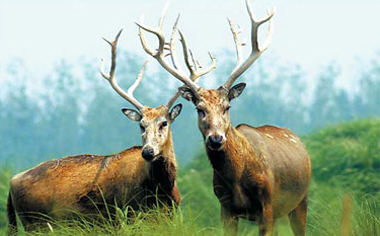More than 1,000 years ago, when the great scholar Su Shi (1037-1101) visited the Red Cliff at the lower reaches of the Yangtze River with a friend, they marveled at the great changes that had taken place since Cao Cao waged a huge battle against Sun Quan and Liu Bei back in the Three Kingdoms Period (AD 220-280).

Chinese people have regarded Milu deer as a symbol of the carefree life of the immortals for about 2,000 years.
"Xiakou lies to our west and Wuchang to the east. Surrounded by mountains and waters, covered in lush green trees and grass, isn't this the place where Zhou Yu defeated Cao Cao?
"You and I go fishing and cut firewood on the islet. We find companionship in the fish and shrimp, enjoy the friendship of the Milu deer "
Milu, an aboriginal species in China, has been a symbol of the carefree life of the immortals for some 2,000 years. There were, at one time, so many Milu deer that the Chinese coined a funny name for it - "sibuxiang", or "none of the four alike" for its unique appearance - a horse's face, a donkey's tail, cow-like hooves and a stag's antlers.
But like many species that once roamed the earth freely, the Milu deer has been pushed to the verge of extinction by humans. However, it is also through the relentless efforts of humans that the deer has been saved.
Milu, which once populated the swamps of Central China, was nearly extinct by the mid-19th century. In 1865, French missionary and naturalist Pere Armand David discovered a few hundred Milu at the former Imperial Hunting Park of the Qing Dynasty (1644-1911) in southern Beijing.
As the missionary sent a few Milu to Europe, the species is recorded as Pere David's deer. Even as wars, floods and famine wiped out the country's Milu population in the 1900s, the 11th Duke of Bedford in England gathered 18 Milu from zoos across Europe and raised them on his manor 45 miles north of London.
It was not until 1985 that the Milu finally got a chance to return home. Lord Tavistock, the 14th Duke of Bedford, returned 20 Milu to its homeland as China and Britain inked an agreement to save the species.
The first batch of Milu settled down well at the Nanhaizi Milu Park, the former imperial hunting park in Beijing, and began breeding in 1987. Inspired by this success, Lord Tavistock sent more Milu to China.
The deer has a strong ability to adapt. Besides Beijing, Milu are also thriving under human care and in the wilderness in the nature reserves at Shishou, Hubei province, and Dafeng, Jiangsu province. Both are located in the lower reaches of the Yangtze River, where Su Shi talked about befriending the Milu.
Ding Yuhua, who has been taking care of the Milu at Dafeng for some 20 years, didn't know what to feed the deer at first. He offered them different kinds of grass and eventually found 198 kinds suitable, many of which had never before been recorded.
In 1987, a pregnant Milu delivered at Dafeng. When the wobbling newborn fell into a nearby ditch, Ding rushed out of his hiding place, dried the fawn with his coat, put it back to its mother and quickly ran away.
Ding, nicknamed "Milu's Father" by his colleagues, has been supporting the return of the Milu to the wilderness with other experts. In 2003, a fawn was born in the wild at Dafeng. This was decisive for the "flagship species" of the wetland ecosystem to be removed from the red list of endangered animals by the World Conservation Union.
Today, more than 2,000 Milu live in the world. The best place to see the legendary deer is Nanhaizi, where a male fawn was born on April 11 this year as China's first artificially conceived Milu.
Guo Geng, vice-director of the Nanhaizi Milu Park, has devised a few ingenious methods with his colleagues to help visitors understand the importance of the Milu.
The park, which is a famous bird-watching spot in the capital, has ancient poems about the Milu carved on the benches to remind people that they should strive for harmony with nature.
(China Daily April 28, 2008)